Pachyveria, sometimes referred to as x Pachyveria, are hybrid succulents that are a cross between Pachyphytum and Echeveria. They are rosette-shaped succulents that come in a wide array of shapes and sizes.
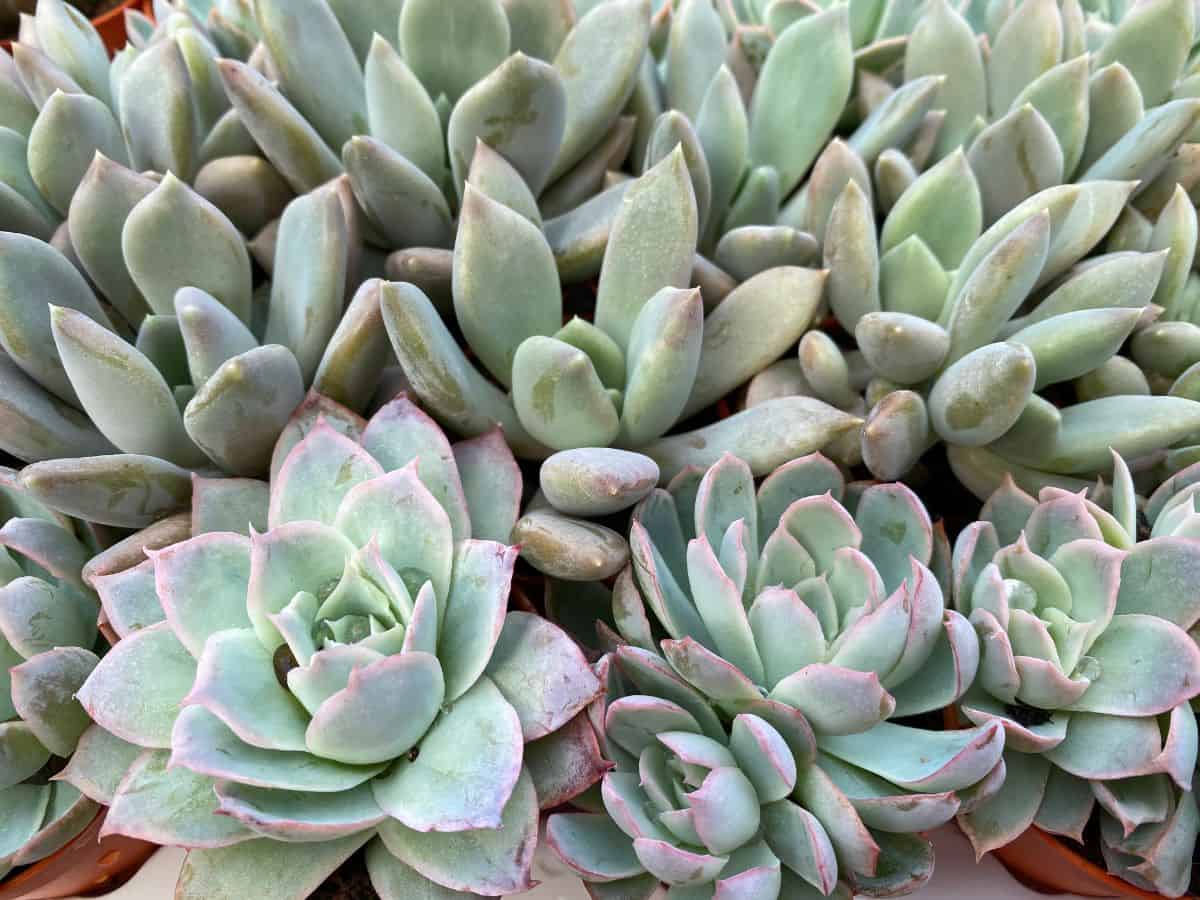
There are a multitude of Pachyphytum cultivars, but they are one of the most popular succulent hybrids on the market. Gardeners love how easy they are to care for, and their unique appearances are a bonus.
Jump to:
Pachyveria Appearance
| Name: | Pachyveria |
| Soil: | Well drained soil |
| Blooming: | Summer |
| Light: | Bright light |
| Water: | When the soil is completely dry |
| Propagation: | Cuttings, offsets and seeds |
The appearance of Pachyveria varies according to the specific cultivar you’re dealing with, but in general, they are rosette-shaped succulents that grow to reach between 2 and 6 inches in diameter.
They come in a range of colors and shapes. Some cultivars may appear to have more characteristics from one parent plant than the other, which is common in hybrid species of succulent.
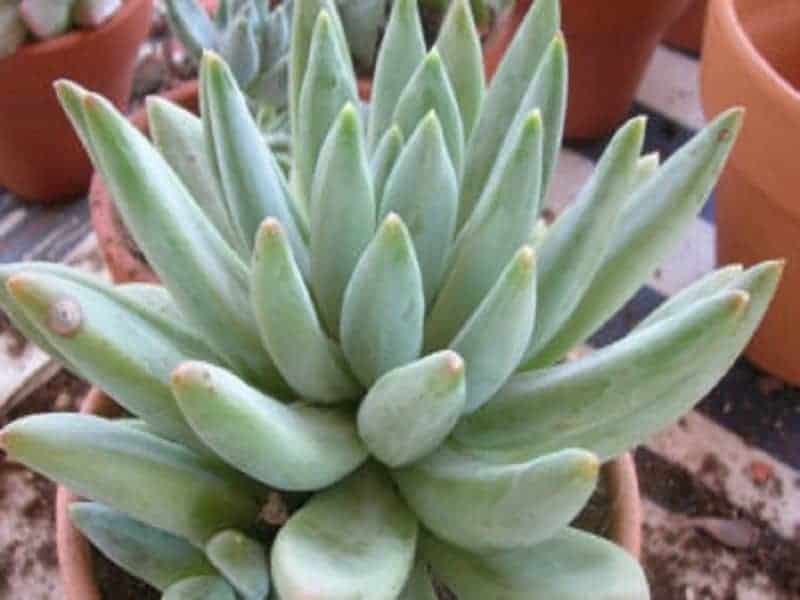
Buy it from:
Common Cultivars
There are quite a few different x Pachyveria cultivars on the market with new ones appearing every year. Here are a few of the most common cultivars:
Pachyveria ‘Little Jewel’
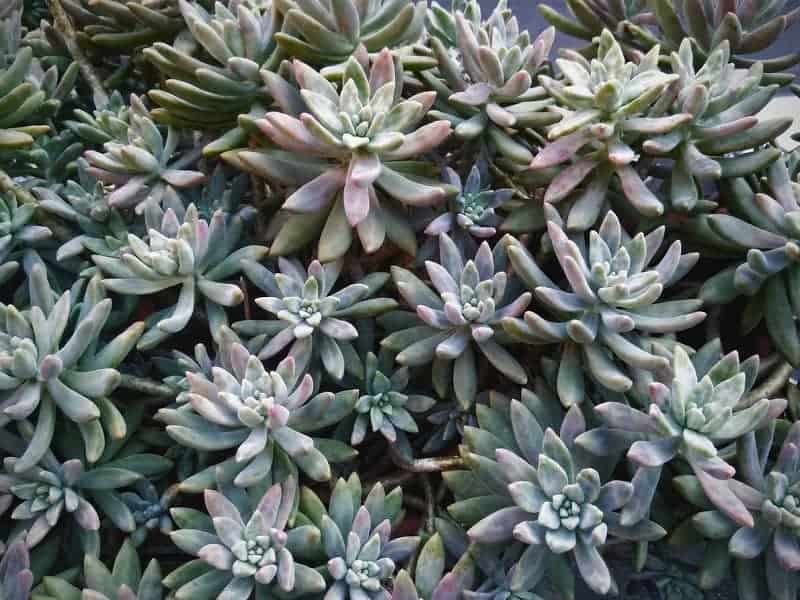
Buy it from:
Pachyveria ‘Little Jewel’, also known as Pachyveria ‘Glauca’, is a petite succulent with thick, almost cylindrical leaves. The spike-shaped leaves are silvery-blue in color with red tips. The leaves also have a powder coating, known as farina.
When in bloom, Pachyveria ‘Little Jewel’ produces petite flowers that are peachy pink and yellow in color.
Pachyveria ‘Powder Puff’
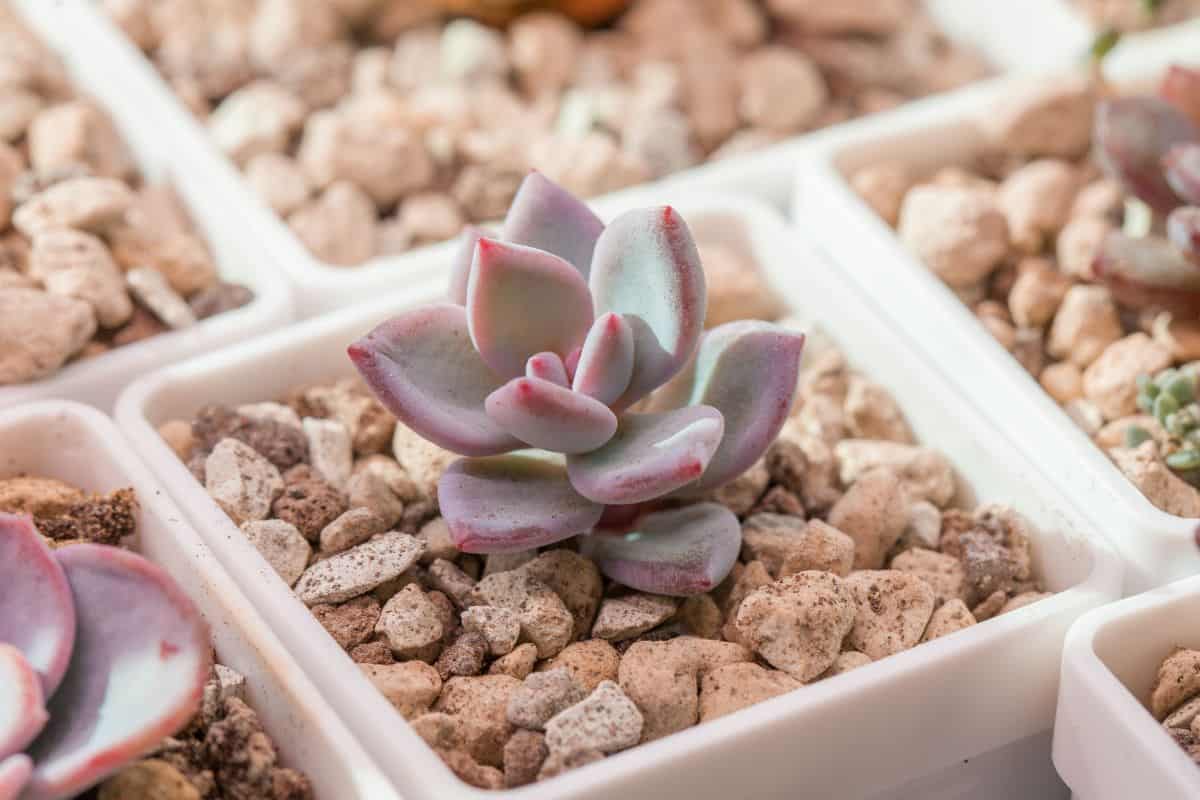
Buy it from:
Pachyveria ‘Powder Puff’ also goes by the names ‘Exotica’ and ‘Kobayashi’. It’s a gorgeous succulent with leaves that look exactly like what you might expect from this hybrid. The leaves are silvery-blue in color, but they take on a lavender or violet blush when stressed.
No products found.
Pachyveria ‘Powder Puff’ blooms in summer and produces tiny, apricot-colored flowers.
Pachyveria ‘Bea’
Buy it from:
Pachyveria ‘Bea’ is not as vibrant as other cultivars, but it still has plenty of charm. The bluish-gray leaves are long and pointed. This succulent can reach up to 6 inches in diameter. The leaves of ‘Bea’ have the faint markings of its parent plant Pachyphytum compactum.
Pachyveria ‘Myrtilla’
Buy it from:
Pachyveria ‘Myrtilla’ is known in Australia and Asia as Pachyphytum ‘Violescens’. This hybrid cultivar resembles its Echeveria parent in leaf shape. It’s a large succulent that can reach up to 10 inches in diameter at maturity.
The spoon-shaped leaves of ‘Myrtilla’ are a reddish-green color, softened by a coating of farina. When stressed, the plant can turn a vibrant pink or mauve. When in bloom, ‘Myrtilla’ produces bell-shaped flowers that are red and orange in color.
Pachyveria ‘Clavifolia’
Buy it from:
Pachyveria ‘Clavifolia’ is also known as Jeweled Crown or Powdered Jewel Plant. It’s a petite succulent, typically staying under 3 inches in diameter at maturity.
The leaves of ‘Clavifolia’ are fleshy, blue-gray in color, and have slightly pointed tips. The tip and margins of the leaf take on a pinkish hue when grown in full sunlight. In spring, this succulent produces clusters of orangish-red flowers.
Pachyveria ‘Scheideckeri’
Buy it from:
Pachyveria ‘Scheideckeri’, sometimes known as ‘Schedeckeri’, is a compact rosette succulent with thick, pale bluish or greenish-gray leaves. This is not a hybrid that can be reproduced consistently and as a result, they vary in size.
Some ‘Scheideckeri’ may also have variegated or even distorted leaves. In spring and summer, this succulent produces clusters of orangish-red flowers.
Pachyveria ‘Clavata’
Buy it from:
Pachyveria ‘Clavata’ has elongated, flat leaves that are grayish-green in color. They can reach up to 8 inches in diameter at maturity. In spring or summer, ‘Clavata’ produces clusters of reddish flowers atop a stem that can reach up to 10 inches in height above the center of the rosette.
Caring for Pachyveria
Though it may seem daunting to care for a hybrid succulent, Pachyveria aren’t any more difficult to care for than their parent plants. As long as their basic needs are met, they should be around to decorate your garden for years to come.
Light
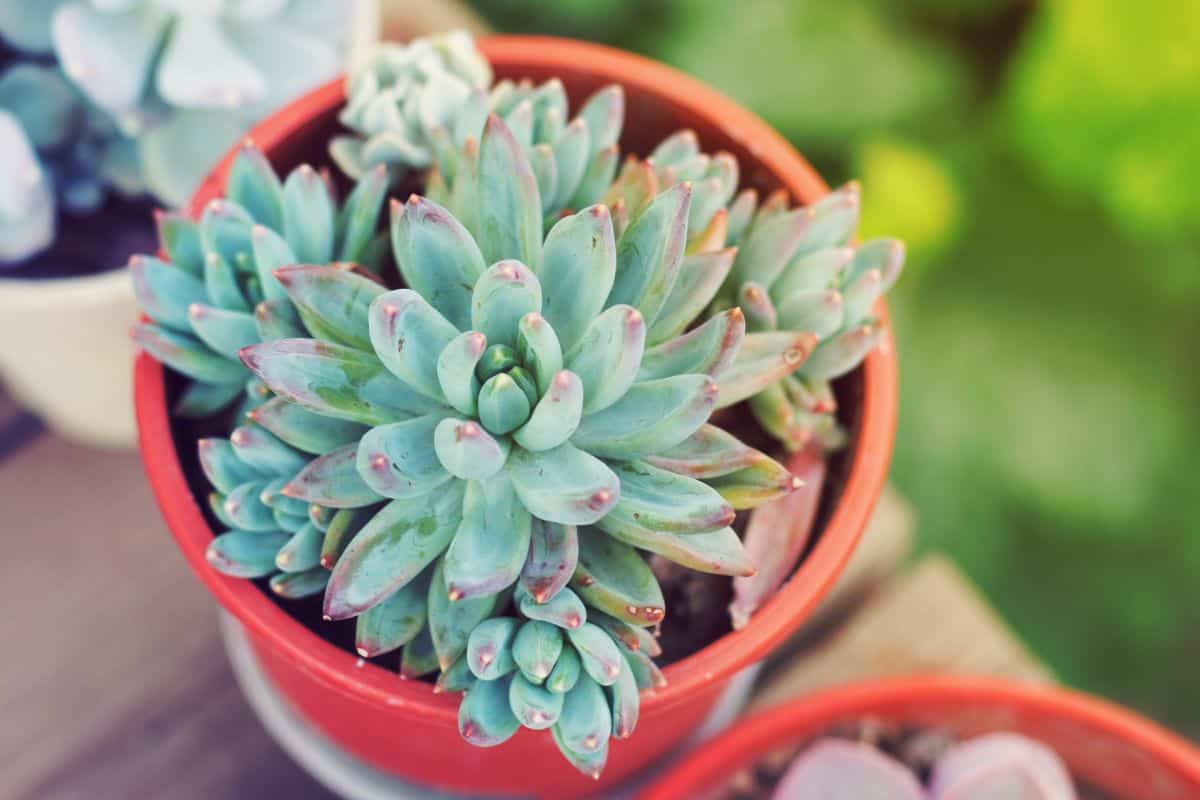
When grown indoors, Pachyveria require plenty of bright light. A south-, west-, or even east-facing window is ideal for this beautiful succulent. Some cultivars can tolerate more light than others, but in general, this species enjoys sitting in your sunniest window.
If you live in a climate that allows Pachyveria to grow outdoors, plant in full to partial sunlight. Just be sure to slowly increase your plant’s light levels over a period of several weeks before leaving it in full sun. This transition period allows the succulent to adapt without the risk of sunburn.
Water
As with Pachyveria’s parent plants, deep but infrequent watering is ideal. Overwatering will surely lead to root rot, so it’s best to allow the soil to dry out before watering again. This is a succulent that is far more tolerant of underwatering than overwatering.
Pachyveria grow more in the winter than in the summer, so you may need to water more frequently to give the plant everything it needs to grow.
Temperature
As with its parent plants, Pachyveria is not a cold-tolerant succulent and will not survive temperatures below freezing. A light frost may be fine, but extended periods of freezing temperatures will spell trouble.
Pachyveria is tolerant of high heat, so if you live in a climate where it gets very hot during the summer, your succulent should be fine. However, you may need to water it more frequently during periods of extreme heat.
When grown indoors, the temperature isn’t generally a concern, but it’s best to protect your succulent from sudden drafts if possible.
Soil
As with most succulents, well-draining soil is essential to the health and wellbeing of your Pachyveria. Water retaining soils should be avoided at all costs as they can contribute to accidental overwatering.
Avoid soil mixes with large amounts of clay, peat moss, or coconut coir, and instead look for soils with coarse sand, gravel, perlite, or bark. These ingredients promote proper drainage and good root health.
Always remember to plant your Pachyveria in a container with a drainage hole to further encourage proper drainage. Allowing the excess moisture to drain away from the soil will help prevent root rot.
Pachyveria Propagation
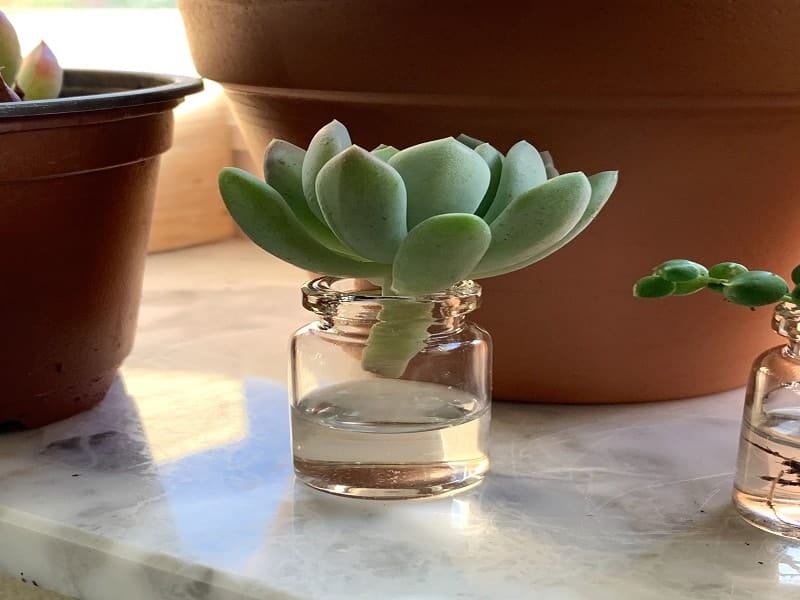
If you’re nervous about propagating a hybrid succulent like Pachyveria, don’t be. Propagating this beautiful plant is as easy as propagating either of its parent plants. It’s a relatively simple process that can be accomplished by gardeners of any experience level.
Offsets
The easiest and quickest method of propagating Pachyveria is by separating the offsets from the mother plant. As this plant grows, it produces smaller versions of itself around the base. These offsets, or pups, are easy to remove and transplant.
To remove an offset, gently pull it away from the parent plant by holding the offset around the base. Gentle maneuvering should loosen it from the soil without too much damage to the roots.
You can also cut the offset away using a clean, sharp knife. Try to separate the offset from as close to the mother plant as you can. This will help to preserve the pup’s existing root system, which will increase your chances of propagation success.
After separation, allow the offsets to dry for a few days to allow the cuts to callous. This helps to prevent infection by fungus or bacteria once you plant it in its new soil.
Once the cuts have calloused, you can plant your baby Pachyveria in a new container. Caring for your new plant is as easy as caring for a mature Pachyveria.
Cuttings
If you’re looking for a bit more of a propagation challenge, consider using leaf or stem cuttings to propagate your Pachyveria. Cuttings are a bit more time consuming than offsets, simply because you have to wait for them to grow into full succulents with functional root systems.
For stem cuttings, you’ll simply need to snip the top few inches from any stem. Be sure to use clean, sharp scissors to ensure a clean cut and minimal damage or risk of infection.
Most gardeners prefer to take leaf cuttings from the base of the plant, but the process is still the same. Snip or gentle tug the leaf away from the stem, breaking it off as close to the stem as possible.
Once you’ve collected your cuttings, you’ll need to let them air dry for a few days to let the wounds callous.
After the cuts have calloused, you can set your cuttings on moist, well-draining soil to await root growth. Be sure to keep your cuttings out of direct sunlight during this period. Soon you’ll begin to see tiny roots and a tiny rosette.
Seeds
It’s also possible to grow Pachyveria from seeds, if you’re so inclined. As with most succulents, this is not a fast process, but it is a fun and interesting way to expand your succulent collection. Seeds can be collected from your existing plants or purchased online from any reputable seed vendor.
Sow your Pachyveria seeds in moist, well-draining soil. It can take up to several weeks for the seedlings to sprout, so it’s important to be patient. Keep the soil moist, but not overly wet. With any luck, you’ll soon see tiny Pachyveria seedlings sprouting from the surface.
Sources:


